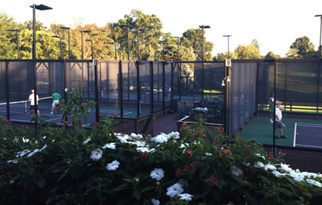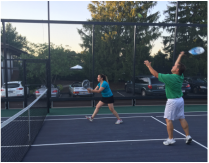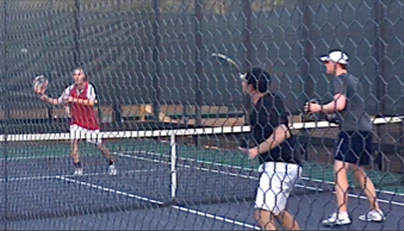|
To accommodate the demand, we have added a third time slot at Cincinnati Country Club. We are also continuing to talk with a few other centrally located clubs about adding more courts. With the addition, the Fall/Winter league will be able to accommodate 130 players. If you, or someone you know, wants to participate - sign up immediately: Fall/Winter Session #1 Sign Up.
The new time slots at CCC will be 5:30 to 7:00, 7:00 to 8:30 and 8:30 to 10:30. All of the time slots at other sites will be 6:00 to 8:00. Players will still be able to specify time slots. Our current list of 124 players includes:
Captains have been selected for our "virtual" teams. Captains will meet at 7:00 on September 10 to participate in a player draft. The draft will be held in conjunction with our "Summer Session #2 Finale - Reverse Draw Tournament." Anyone can sign up for the event - but the event will be capped at 32 players and priority will be given to Summer Session #2 participants. The 2015-16 captains and draft order are listed below:
0 Comments
The American Platform Tennis Association (APTA) has released the tournament schedule for the 2015-16 season. For an overview of local, regional and select national tournaments view our "tournaments" page.
PT League - Summer Session #2 Finale: Reverse Draw Tournament The second summer session will conclude Thursday, September 10. A "Reverse Draw" tournament will be held from 7pm to 11pm that night. There will be beer, water & pizza for all participants. Click for complete details and sign up. Cincinnati to host APTA Mixed Nationals this Year Cincinnati has been selected to host the national mixed doubles tournament this year. Two events, the Husband/Wife Nationals and the open Mixed Nationals will be held March 18 to 20. This is a major event every year with 64 draws in each event. Top ranked male and female players participate. The tournament will need local support to fill out the draws. As with all APTA tournaments, there are multiple backdraws and each team is guaranteed at least three matches. Any player playing at a d-1 level or higher in Cincinnati should plan to play in at least one of the events. More info: APTA Mixed Nationals Cincinnati's "Midwesterns" Awarded Elite Grand Prix Status The APTA has created a new elevated tier of tournaments for the 2015-16 season. Five tournaments were selected to be a part of the Grand Prix Series. Among other things, these events will have a guaranteed multiplier of at least 3.25 for men's events. All of the women's events will be rated 4 with the exception of the Midwesterns which will be guaranteed a 2 rating. Each tournament can still be rated higher based on the competitors, but the "guaranteed" points is new for APTA events. The Midwesterns new status will give a significant boost to the women's event, which has traditionally been rated a 1. The points will now be doubled and should help attract a larger, more national field. The men's tournament has been one of the highest rated tournaments for the past few decades. It is above 3.5 most years, so the new rating system won't make a huge difference. But, the new designation should help to keep the Midwesterns one of the top national events. Click for a detailed explanation of the new Grand Prix Series.  Jim Meranus gained 20 points by winning his upper level court with Bret Bruder, Scott Kiker, David Wellinghoff and Scott Degerberg. With the win, Meranus raised his season point total to 52.5, good for a 17.5 average and fourth place in the overall standings. Standings leader Pete Tarnowski was idle this week and now shares first place with Doug Jones. Other court winners were: Jones, Patrick Herrel, Dave Peck, Scott Degerberg and Lee Workum. Click to view the updated standings or full week #5 results.  Fall/Winter Session #1 will start on Thursday, September 17. Session #1 will play 13 weeks and last until December 17 (skipping November 26). The second session will start January 7 and last through March 31. We are currently over capacity at 124 players. 108 is considered full for the number of club courts we currently have reserved. We added a private court - Signal Hill Lane (Near Lunken off 32) - to help with this. We are also talking to a few other clubs about using two more courts. Current Players (124) Matt Allare, Rob Bakker, Kathy Barton, Kyle Bates, Pete Bernhard, Andrew Beto, Bill Boughton, Scott Bristow, Brian Brockhoff, Bret Bruder, Martin Bruemmer, Carlos Canelas, Richard Canelas, Greg Carr, Robin Carr, Porter Castleberry, Mike Caudill, Sarah Chasnoff, Chang Cho, Jim Ciesick, Brett Connelly, DeWitt Cook, Karen Crowley, Steve Crowley, Brett Decurtins, Scott Degerberg, Jay Dollries, Jack Dowling, Tom Eisenzimmer, Ryan English, Bart Fitzpatrick, Anne Flottman, Tom Flottman, John Fovel, Lawrence Gamblin, Karen Games, Robert Gerwin, Jim Getgey, Sally Giannella, Pat Gilligan, Tracy Glassmeyer, Glynn Goertzen, Tony Guastaferro, Hansen Jasen, Richard Hartke, Andy Heldman, Jim Heldman, Ken Heldman, Mike Herrel, Patrick Herrel, Ron Johnston, Doug Jones, Andrew Jordan, Richard Joseph, Ron Joseph, Michelle Keating, Gene Kennedy, Scott Kiker, Bob Kooris, Adam Kwiecinski, Rick Lauer, Mike Lint, Lee Lonergan, Amy Lutz, John McElhenny, Matt McIntire, Scott McIntosh, Lisa McLaughlin, Chris McRae, Jeanne Miller, Brian Mitchell, Dave Montgomery, Dan Mott, Pat Mueller, George Musecamp, Patty Nash, Larry Newman, Tom Nurre Jr., Chris O'Brien, Guy O'Gara, Sue O'Gara, Anthony Palmenter, Ken Palmer, Dave Peck, Brad Pierce, Mark Pohlman, Heather Prop, Keith Rabenold, Steve Rafalo, JR Randall, Thaddeus Reed, Ken Rieser, Jeff Roman, Craig Rowitz, Barry Rudell, Gina Saba, Peter Saba, Kaki Scheer, Fabian Schmahl, Kathy Schneider, L.V. Semona, Anne Shanahan, Patrick Shiels, Ralph Shine, Erik Simonson, Brent Sitarski, Jim Stutz, Andy Taylor, Michael Todd, Eric Toth, Scott Triplett, Douglas Ucci, Mary Ucci, Courtney Ulrich, Scott Vaaler, Diego Vallota, Ron Visscher, Steve Watts, Evan Webeler, David Wellinghoff, Kyle Wilkins, Amy Wolber, Jeff Wolf, Lee Workum
 Pete Tarnowski won two upper level courts and took the early season lead in the standings. Tarnowski has played four sessions and has a 21.75 point average. Other court winners were Bob Kooris, Scott Kiker and Adam Kwiecinski. Anthony Palmenter and JR Randall shared first on an upper level court. Brantley Dreisbach and Scott Degerberg split points on a lower court. Results. Tips for Playing in the Rain: Platform tennis is played outdoors in all types of weather conditions. Each different condition presents it's own set of challenges. Each has specific strategies and tactics proven to help you perform better. This week we played part of the 7:30 session in pretty wet conditions. I thought I would present a couple of tips for improving everyone's rain play while the memories of hydroplaning shin busters are still fresh. The Serve: Holding serve in the rain is critical. It becomes difficult to hit offensive returns and harder to win points from the baseline. This makes breaking serve much less likely. Therefore, if you get broken by a team with two good rain servers, it is probable that you will lose the set. The most common way players lose their serve in the rain is by faulting too often. Servers who rely on a lot of spin are more prone to faulting in the rain. The solution is to add more weight to your shot by hitting the back of the ball rather than the side. Making contact with the ball higher and not as much to your right side (right-handers) aids this. You must force yourself to come in and be ready to volley. Staying back is not a great option. Always approach favoring your backhand volley as almost all returns hit higher than your shoulders are going out in the rain. Good returners tend to take more chances because they know how much harder winning a prolonged point from the baseline will be. Controlling the net through the first three shots (serve, return and first volley) yields even greater benefits than in normal conditions. Oddly enough, another common way to lose serve is by being too afraid to fault. Push servers who rely on hitting a ball that arcs high over the net run the risk of having the lone returnable serve on the court. The high arcing serve tends to bounce straight up with no skid. To correct this, hit the ball at a higher point than you are accustomed to. Try to create a less arcing, more downward ball flight. These servers will benefit from taking a little more risk on the serve. Serving 100% is not necessary in the rain. In PT there is always a risk-reward factor to consider. Since skidding your serve yields such high rewards, it is worth risking a few faults. Playing from the Baseline: Take more chances. Playing prolonged defensive points becomes risky because of how difficult the shots become. When possible, attempt transitional shots from typical defensive positions. Do not pass on decent offensive chances. Lob high. Excessively high if possible. Use these lobs to create drive opportunities off your back screen. Overheads are tough to spin off of high lobs in the rain, especially as they get deeper than the service line. The tendency is for the overhead hitter to strike the ball at a higher point than usual and add depth to the shot. These balls generally come off the back screen high and out into the court. You can now drive the ball easier because it is higher than the net - this compensates for your inability to control drives with topspin in wet conditions. The overhead hitter's only other option is to push his overhead softly, which off the high lob is tougher to control. Now he runs the risk of hitting a ball that naturally bounces higher off the deck, giving you an equally good drive opportunity. If you notice this happening, taking some chances with the blitz can also be beneficial. Drive primarily crosscourt and rely on opponents missing volleys. The crosscourt shot travels over the low part of the net, which enables you to hit a flatter drive. It also creates a much longer (diagonal) path than a down-the-line shot. These factors give you more room for error. Do not try to pass your opponents cleanly when hitting their paddle with the wet ball will suffice. This too gives you much more room for error as it is very common to volley balls that are going out in the rain. This is because players fear losing control of the net and know retrieving the ball off the back screen is less of an option. They become highly focused on hitting volleys, thus more prone to making a play on the "out" ball. Do not blitz on your partner's return of serve. First, the returner is likely to make contact "late" because the ball skids fast at him. This means the return will not go crosscourt but flutter down the line. Not a good situation for a blitzer. Second, it is very hard to make solid contact and mishits are common. Again, not a good blitz situation. Third, but most importantly, successful blitzing relies on the returner hitting down at the net rusher. This forces him to hit volleys up and creates easy volleys for the blitzer. Most rain serves never bounce higher than the net, thus the returner can't hit returns down at the net rusher. Playing the Net: Don't take chances. Once you have control of the net, understand that your percentages for winning the point are very high if you just play good defense. Any time you are pushed more than five feet back off the net, simply look to keep the point in neutral - meaning don't give the baseline team anything that bounces higher than the net that they can drive. If they hit a short shot, within five feet of the net, you can go for slash winners and drop shots - but only if you can make them near 100% of the time. Equipment: Heavy paddles work better than light ones. Gritty paddles work better than smooth. Gloves work well - wide receiver gloves better than racquetball (but only in the rain). Tournagrip original works well too - but never in combination with a glove. Catcher's masks, chest protectors and shin guards are also useful.
|
Archive
July 2024
CategoriesAuthorDoug Jones. |
About | Contact | Standings | Results | Schedule | Directions | Email Subscribe | New Players | All | S2 | N2 | A2
Proudly powered by Weebly

 RSS Feed
RSS Feed